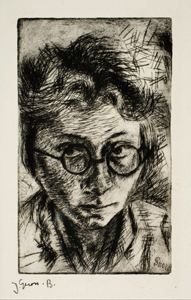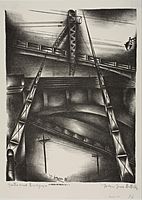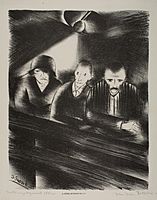Jolán Gross-Bettelheim facts for kids
Quick facts for kids
Jolan Gross-Bettelheim
|
|
|---|---|

Self portrait c. 1929
|
|
| Born | January 28, 1900 Nitra, Hungary (now in Slovakia)
|
| Died | July 29, 1972 (aged 72) Budapest, Hungary
|
| Known for | Printmaker |
Jolán Gross-Bettelheim (January 28, 1900–July 29, 1972) was a talented Hungarian artist. She lived and worked in the United States for many years, from 1925 to 1956. After that, she returned to her home country, Hungary.
Contents
Early Life and Art Studies
Jolán Gross-Bettelheim was born on January 28, 1900, in Nitra, which was part of Hungary at the time. Today, this city is in Slovakia. She moved to the United States in 1925.
Jolán loved art from a young age. She studied painting at the Budapest School of Fine Art in 1919. Then, she continued her studies in Vienna at the Kunstgewerbeschule. She also went to the Akademie der Bildenden Künst in Berlin. From 1922 to 1924, she studied in Paris at the Académie de Grande Chaumière.
In 1925, she married Frigyes Bettelheim, a radiologist also from Hungary. They settled in Cleveland, Ohio. There, Jolán continued her art education at the Cleveland School of Art. She learned from a famous artist named Henry Keller. In 1938, Jolán and her husband moved to New York City.
Jolán Gross-Bettelheim was interested in social justice. She was a member of groups like the John Reed Club and the American Artists’ Congress. These groups were for artists who wanted to use their art to talk about important social and political issues. She also shared her art in newspapers and magazines that supported workers' rights, such as New Masses and the Daily Worker.
Art in Cleveland and the WPA
When Jolán Gross-Bettelheim worked in Cleveland, printmaking was very popular. Printmaking is a way to create art by transferring an image from one surface to another, like a stamp. Lithography, a type of printmaking, became a respected art form, not just for commercial use.
Art groups helped make printmaking more popular. The Cleveland Print Makers (CPM) was started in 1930 by artist Kálmán Kubinyi. This group helped Cleveland printmakers show and sell their art. They even opened a special gallery called the Print Mart or Market.
In November 1936, the Print Market hosted a big art show called America Today. This show happened in 30 cities across the U.S. at the same time. It featured 100 prints by artists from the American Artists' Congress, including Jolán Gross-Bettelheim. She also made a print for the CPM’s "Print-a-Month" series. This was a subscription where people received one new print each month.
During the Great Depression, the U.S. government created the Works Progress Administration (WPA). The WPA had a program called the Federal Art Project (FAP) to help artists find work. This program included a graphic arts division for printmaking. A special workshop for graphic arts was set up in Cleveland. Jolán Gross-Bettelheim created prints for this WPA workshop. Her work was also shown in a traveling exhibition called Fifty Prints of the Year.
Later Life and Artistic Themes
After 1956, Jolán Gross-Bettelheim returned to Hungary. She passed away in Budapest on July 29, 1972.
Jolán Gross-Bettelheim's prints often showed the difficult times of the Great Depression. She used a style called Cubism, which uses geometric shapes and different viewpoints. This style made her cityscapes and industrial scenes look very dramatic. One art expert, Sabine Kretzschmar, called her "the purest modernist" among Cleveland printmakers. Her art showed influences from German expressionism, constructivism, and cubism.
Her artwork often explored important social and political topics. For example, her print In the Employment Office (around 1936) showed the struggles of unemployment. Her print Workers Meeting (Scottsboro Boys) (around 1935) addressed racism.
Her black and white images often showed people feeling small or overwhelmed by large industries. For instance, her 1940 lithograph Assembly Line shows a crowded factory space. It includes a striking image of gas masks lined up on an assembly line. Her 1936 lithograph Civilization at the Crossroads (Fascism II) warned about the growing threat of Fascism in Europe.
Gallery
Art Collections
Jolán Gross-Bettelheim's artwork is held in many important art collections, including:
- Smithsonian American Art Museum, Washington, D.C.
- Cleveland Museum of Art, Cleveland, OH.
- Art Institute of Chicago, Chicago, IL.
- Zimmerli Art Museum at Rutgers University, New Brunswick, NJ.
- University of Michigan Museum of Art, Ann Arbor, MI.
- Akron Art Museum, Akron, OH.
Exhibitions
Jolán Gross-Bettelheim's art has been shown in many exhibitions over the years:
- May Shows at the Cleveland Museum of Art (almost every year from 1927-1937)
- Kokoon Club, 1932 (her first solo exhibition)
- American Today, 1936
- American Artists’ Conference Exhibition, 1938
- Artists for Victory, 1942, at the Metropolitan Museum of Art in New York
- Artists for Victory, 1943 (a show held in 36 museums at once)
- America in the War, 1943
- Library of Congress annual print shows, Washington, DC (1943-1950)
- Annual Exhibition of Northwest Printmakers, Seattle Art Museum (1944-1953)
- Durand-Ruel Galleries in Manhattan, 1945
- Art Institute of Chicago (two watercolor shows)
- Modernist Abstraction in American Prints, Laguna Art Museum, 1992
- Jolán Gross-Bettelheim: The American Prints, Faulconer Gallery, Grinnell College, 2001
- Jolán Gross-Bettelheim: An American Printmaker in an Age of Progress, Zimmerli Art Museum, 2011
See also
- American Artists’ Congress
- List of Federal Art Project artists
- Society of American Graphic Artists




